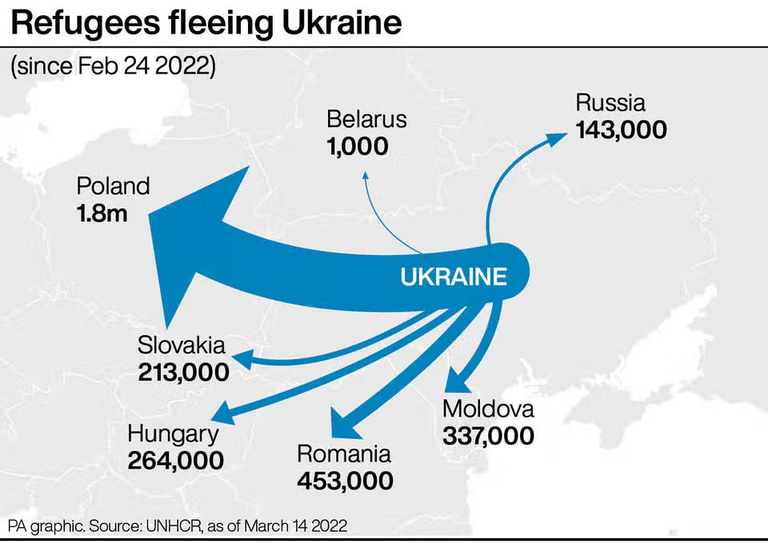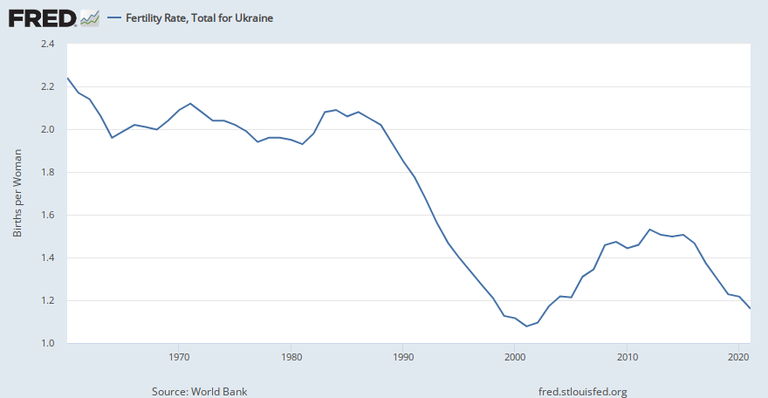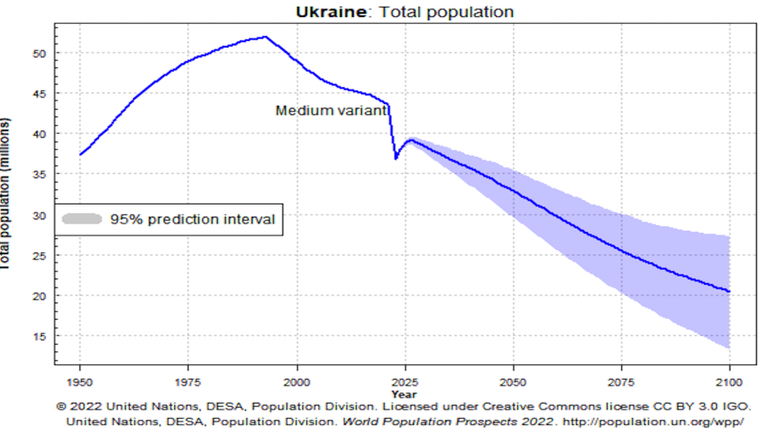
As you probably already know, much of the world is suffering through a demographic crisis. Fertility rates are falling, putting more pressure on public services and straining national budgets. Europe is no exception, and most European countries have aging, if not shrinking populations. However no European country is suffering through as acute a demographic crisis as Ukraine. Even before the war, Ukraine was struggling with high emigration and low fertility rates. But Putin's invasion has understandably exacerbated this pre-existing demographic crisis and the latest data suggests that Ukraine now has literally the lowest fertility rate in the world. So in this article, we're going to have a look at Ukraine's pre-war demographic crisis, how the war exacerbated it and how this affects Ukraine's political future.
So to understand this article you're going to need a bit of context. To maintain a stable population, a country needs a fertility rate. That is, the number of births per female of 2.1. Low fertility rates that is a fertility rate significantly below the replacement rate of 2.1 are economically and politically stressful. This means there will be less people of working age relative to pensioners, which means a smaller, economically productive population sustaining a relatively larger non-productive population. This means two things one a smaller economy overall because you've got fewer working age people and two a higher tax burden on those young people that are working. This is because assuming you want to maintain your current quality of public services, you need to make sure you're getting the same amount of tax per capita. But if you've got fewer working age people and more idle pensioners, then you need to tax those working age people more heavily to keep standards up. This is both bad economically, a higher tax burden will at least in theory discourage working and bad socially because it creates intergenerational unfairness.

Most of the developed world, and actually quite a lot of the developing world, is struggling with low fertility rates. The US for example has seen its fertility rate fall from about 4 in 1960 to about 1.8 today, and the latest Eurostat data from 2021 suggests that Europe has a fertility rate of about 1.5. However, none of these countries even compare with Ukraine. Like most post-Soviet countries Ukraine saw its birthrate collapse in the 90s, going from two in the 1980s to a low of 1.09in 2001. Ukraine reliably had the lowest fertility rate in the post-Soviet space, but the problem became particularly acute after the war in 2014, with Ukraine's fertility rate falling from 1.5in 2013 to 1.2 five in 2021. At the same time, Ukraine was experiencing high levels of emigration, with many Ukrainians traveling west to Poland and other Central European countries in search of better work and higher standards of living. According to Eurostat data, by the end of 2021, some one and one half million residents permits had been issued to Ukrainians across the EU, making them the third largest group of non-EU citizens.
Even before the invasion, Ukraine's population was falling by roughly half a million people a year, shrinking from over 50 million at independence to about 40 million, and the UN was predicting it would fall to about 25 million by 2100. Unsurprisingly, Putin's invasion has exacerbated the crisis. Not only have tens of thousands of young Ukrainians died in the war and some 6 million more emigrated to Europe but the invasion has also pushed Ukraine's fertility rate to unprecedented lows, according to Ukrainian data analytics company OpenDataBot Ukraine's birth rate has fallen by 28% since the start of the war, with 38,000 fewer babies born in the country in the first six months of 2023 compared with 2021. This would imply a total fertility rate of about 0.7, which would be the lowest in the world and far lower than any other developing country. To give you a sense of quite how serious that is, if Ukraine's fertility rate fails to increase and emigration levels stay high, the Institute for Demography and Social Studies at the National Academy of Sciences of Ukraine has forecast that Ukraine's population could shrink to as low as 24 million by 2030. This is less than half of what it was in 1990, and would imply Ukraine's population shrinking by over a million people per year.

Now, it's worth saying that this is a pessimistic estimate, and reliable estimates are hard to come by because Ukraine is currently in such an exceptional situation. Ultimately, Ukraine's demographic future and whether it can recover from demographic winter depends on three things. First, and most obviously, the war. The longer the war goes on, the more acute and intractable Ukraine's demographic crisis will become. I am not saying that this means that Ukraine should sue for peace, but it's nonetheless true that a longer war will exacerbate the demographic crisis in all sorts of ways. Second migration, the question here is how many of the 6 million or so Ukrainians currently taking refuge in Europe, many of them women and children, decide to return home. It's hard to know how many to expect but after the collapse of Yugoslavia, roughly a third of the 3 million or so refugees living in Europe end up returning home. So Ukraine should expect at least 2 million to return.
In the longer term however, what matters will be whether or not Ukraine can bring down its emigration rate. This is one of the potential downsides to joining the EU. Freedom of movement could encourage young. Ukrainians to move to other countries in the EU, exacerbating Ukraine's demographic crisis. This is sort of what happened to Poland in the 2000, after it joined the EU when lots of young poles left their homeland to go work elsewhere in Europe in search of higher wages and better living standards. Ukraine could offset this by increasing external immigration, which is sort of what the Polish government did in the early 2010s but this would be politically difficult. Third, the economy. Unsurprisingly, Ukraine's economy has been decimated by the war, with GDP down by at least 30%. While reconstruction might feel impossible in this context history is full of examples of rapid post-war growth. With sufficient Western aid and prudent politics, it's at least possible that Ukraine could see a Germany or South Korea style recovery. A miracle on the Dnipro. If this were to happen. Young Ukrainians would be far less likely to emigrate, and the Ukrainian state would have the fiscal capacity to support Ukrainian families and stimulate the fertility rate. All in all, while Ukraine's demographic crisis looks pretty catastrophic at the moment, a recovery is at least possible. But while this war continues to drag on, it won't happen for a long time.
Great analysis.
Demographics is destiny.
You didn't mention it but young people are far more effective soldiers than old people. So having very low fertility over a long period makes a country more vulnerable to invasion.
Russia had low fertility rates after 1989 too but during the Putin era they have risen significantly (but still below replacement).
Interestingly the other war in the news involves Israel, which has by far the highest fertility of any developed country (3.1) and Gaza which also has very high fertility.
The birth rate in Palestine was 5.44 in 2000, while today it is around 3.5. Compared to countries facing a population crisis, this is a high birth rate despite the state of war they are living in. Of course, there are many sociocultural and economic reasons underlying this. Restrictions in access to sexual protection and hygiene products and having a culturally multi-child family structure are some of them.
If we talk about Israel, unlike other countries, there is an increasing birth rate graph in the last 20 years. I think that Jews with high religious attachment are undoubtedly the ones who have the most share in the establishment of such a graph.
Patriotism and religious observance and the only way to maintain above replacement birthrates in the modern world.